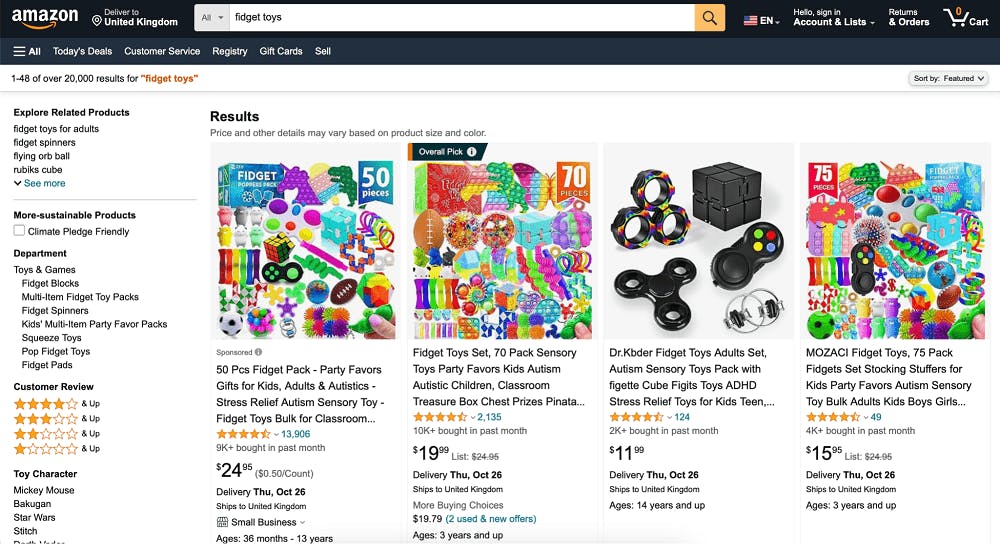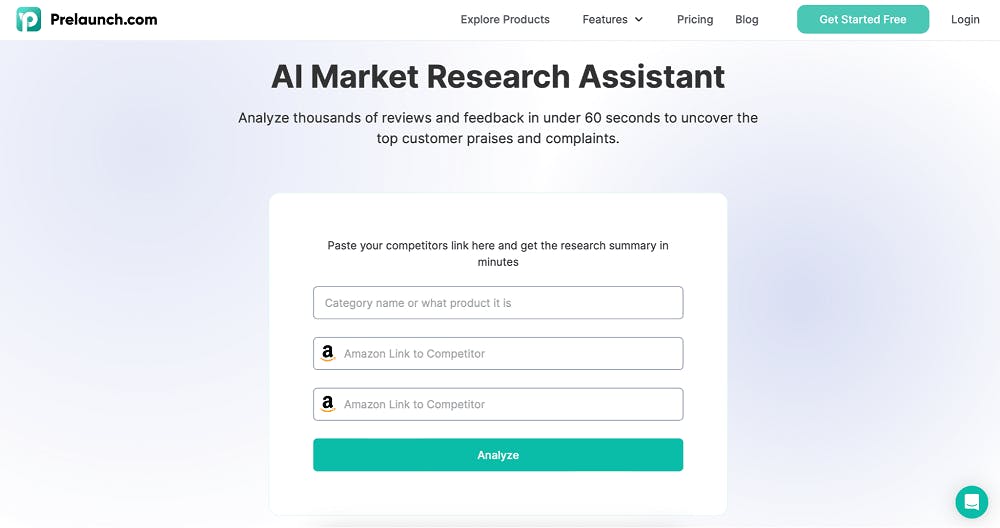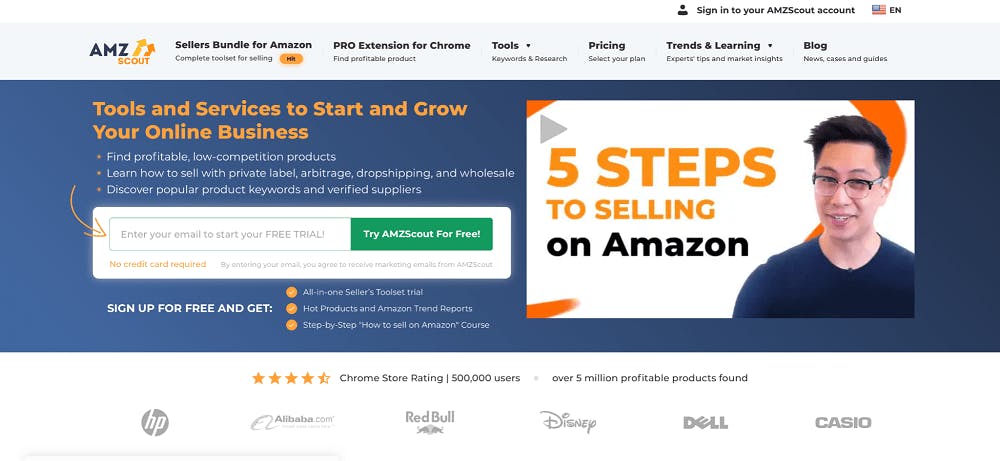Competitor analysis is a core part of any marketing and sales strategy. After all, it’s better to learn from others’ mistakes than to make your own. If you’re running an Amazon store, you should spend a huge chunk of time on Amazon competitor research.
The lessons you can learn from an extensive Amazon competitor analysis are almost infinite. What is working for them? What isn’t? All this info will help you craft a strategy for your products that’ll work the best.
But where do you start when you want to do your Amazon competitor analysis? If you’re a beginner in the sphere, you’ve come to the right place.
In this ultimate guide, we’ll teach you about all the steps you’ll need to take to learn all you need from your competitors.
From understanding the Amazon marketplace and how to find competitors’ keywords on Amazon to a step-by-step guide to competitive research, we have your back. Without further ado, let’s dive right in.
Understanding the Amazon Marketplace as a seller
Before we dive into the intricate details of an Amazon competitor analysis, it’s essential to first understand the basics of the Amazon Marketplace.
As you might’ve guessed, Amazon is the biggest online marketplace in the world. It generated around 4.8 billion monthly visits as of April 2023 and managed to generate $513.98 billion in revenue in 2022.
These numbers make it clear that the opportunities for your store or products on Amazon are big. However, the bigger the market – the bigger the competition, right?
If you want to succeed on the platform, there are 5 factors that you’ll need to consider.
5 characteristics of successful Amazon Marketplace sellers
The basics of Amazon are pretty clear at first glance – you list your product(s) on the platform, attach some photos, add a description, and try to sell as much as you can. But all of this goes much deeper. So, let’s start our Amazon 101 lesson.
- Selling the right product to the right niche.
Just like with any other business, your Amazon Marketplace brand should have an awesome product for sale. Choosing the right product can make or break your success.
Many brands have been on the platform for years and don’t want to give up their #1 spot in a product category. You have to have a strong differentiation point to fight this sort of competition.
Start by researching different niches to find trends in a market that interests you. You can use tools like Google Trends, Amazon’s Best Sellers, or other software to help you find a niche that’ll be popular and profitable for you.
Next, define your Unique Value Proposition (USP). What makes your product better than those of your competitors? Why should a buyer choose your product? This can be anything starting from different product specifications and cheaper pricing to better customer service and quality.
- The art of pricing and profit margins.
Pricing your product on Amazon is a delicate balancing art. Since the price of a product is a major (or sometimes the sole) decision factor for buyers, you truly need to pay lots of attention to it when doing your Amazon competitor analysis.
If you sell the exact same product as your competitor but they sell it for even $1 cheaper, guess whose product a buyer will purchase? This is not to say that you should always have cheaper products than your competitors, but it’s something to consider.
So, start with a competitive pricing analysis. Gather your competitors’ product prices, figure out what sort of discounts they offer, and what other pricing strategies they use. Finding pricing history is easy with tools like Honey.
Don’t forget that your competitors will be looking out for your prices as well. This is where dynamic pricing comes in. Don’t hesitate to use tools that’ll adjust your product’s price based on demand, your competition, and more.
- Optimizing your listings to the max.
Here’s the part where you can get creative. Your listings are your storefront on Amazon – the name, the photo, and the price of your products can attract potential customers or push them away.
If you want your products to get high visibility on the platform, you’ll need to optimize your listings on 3 factors – keywords, images, and product descriptions.
Optimized keywords: To make sure that your product gets higher visibility, you have to use relevant keywords in your product titles and descriptions. Think of it as a search engine. Get into the mindset of your customers and use the words you think they would use when looking for your product.
High-quality images: Use product images that clearly show every aspect of your product from various angles. Make sure that they are visually attractive and eye-catching. Don’t forget to test your thumbnail for maximum visibility.
Enticing product descriptions: Once your images have done their magic and brought a potential customer to your product page, it’s time to seal the deal. Make your descriptions engaging and informative, highlight key features and benefits, and make it persuasive.
- To fulfill yourself or not. That is the question.
When making a purchase, customers also pay attention to the shipping times and methods. As an Amazon Marketplace seller, you can choose between FBA and FBM:
- Fulfillment by Amazon (FBA): With this option, Amazon will handle storage, packaging, and shipping. Plus, your customers will be able to order it with Amazon Prime.
- Fulfillment by Merchant (FBM): This option gives you more control over shipments, but might lose you some sales if you can’t ship as early as they want it.
- Reviews, reviews, reviews
Amazon customers are also heavily influenced by the reviews and ratings your product has. If a product has 1 review and it’s a bad one, no Amazon customer would risk ordering it. However, if you have 500 raving 5-star reviews, you’ll immediately be trusted.
Generating reviews is not easy, but if you truly provide great customer service, you’ll definitely get them. Don’t be afraid to encourage your satisfied customers to leave reviews and feedback, but beware of Amazon’s guidelines. Incentivizing reviews goes against Amazon’s policy.
Once you’ve put checkmarks on all 5 of these points, you can start organically growing your store on Amazon.
Nevertheless, you can’t blindly dive into the marketplace and hope to generate thousands of sales. You’ll need extensive Amazon competitive analysis to be your guide.
9 steps to do a comprehensive competitor analysis on Amazon
Although competitor research might seem like the hardest task in creating your marketing and sales strategies, it is also one of the most vital steps. It can truly give you invaluable insights that’ll pave your way to success.
An extensive Amazon competitor analysis can give you info about the marketplace, your competitors, and help you identify your target audience. And that’s just the tip of the iceberg.
If you want to outsmart your competitors, you’ll need to do this analysis in the right way – so that you can generate actionable takeaways to drive your strategy.
This step-by-step guide to the ultimate Amazon competitive analysis will teach you the 9 steps you must go through (unless you choose to use a smart tool instead). So, let’s dive right in.
Find your competitors
To be able to start researching your competitors, you’ll first need to identify who they are. In the simplest words, your competitors are the sellers who have closely similar products to what you offer.
Finding your competitors is a good place to start learning about your market. Here are 3 ways to do it.
- Research on Amazon: This is the simplest way to find your Amazon competitors. Simply go on Amazon and search for the product you want to sell. Let’s say you want to sell “fidget toys.”

The top results will usually be your top competitors. Write down their names, and save their Amazon product pages so that you can analyze them all later on.
- Do a deep search on Google: Searching for the product you want to sell on Google is yet another great way to find competitors. Of course, they might not necessarily be available on Amazon, but there are still some things you can learn from them.
- Use smart tools: In this digital age, doing things manually can usually be avoided. So, check out tools like the Prelaunch AI Market Research Assistant, Jungle Scout, or AMZScout to find and gather data about your competitors.
Analyze their product pages
With this second step of your ecommerce competitive analysis, you’ll need to check out the product pages of the competitors you gathered up in step 1. This will give you a deeper understanding of their sales strategies.
Later on, you’ll also analyze their pricing and reviews, but for now, here are the main things to pay attention to:
- Product titles: Catchy titles can truly become an engine of traffic for your product. So, pay close attention to the wording your competitors use in their product titles.
- Product descriptions: What sections do your competitors have in their product descriptions? What needs are they addressing? What are their advantages? The answers to these questions can also help you understand their SEO strategy (keywords).
- Images and videos: Analyze the quality of the media your competitors feature for their products. What is the focal point of their images? Do they feature videos?
Understanding the way your competitors have set up their product pages can serve as your guide in this matter.
Analyze their pricing strategy
To fully understand the pricing strategy of your competitors, you’ll need to look at 2 things:
- How has their price changed over the past couple of months?
Tracking the trends in your competitors’ pricing can help you understand seasonality and demand for your own product. Since your pricing strategy won’t only be about setting a price and leaving it the same, this info will help you plan for the future as well.
Your ecommerce competitor analysis can answer questions like these: Are your competitors consistently lowering prices? Are they offering special discounts? Do they bundle products for the holiday season?
- How does their pricing strategy compare to yours?
If you notice that your competitors are pricing their products much higher than you are, then you’ll know what sort of market penetration strategy to use. If their prices are much lower, then you’ll know to position yourself as a high-end seller.
Check out their reviews and ratings
The reviews and ratings your competitors’ products get can help you discover their strengths and weaknesses. This will play a crucial role in another stage of your Amazon competitor analysis – the SWOT.
For this section, you’ll need to pay attention to 2 things:
- Content of reviews: Read through the reviews of your competitors’ products. What are some common complaints? What are some common areas where they thrive? These insights can become your cheat sheet for success.
- Trends in ratings: Analyze the trends in ratings over some time. Do your competitors get high ratings all the time, or are they starting to struggle with negative feedback?
Understand their shipping methods
Understanding the shipping methods, pricing, and times can help you learn a lot about your audience. This has a high impact on customer satisfaction, so if your customers are used to fast and cheap shipping, they won’t settle for anything less.
If you can potentially offer lower costs or faster shipping than your competitors, you’ll be able to gain a competitive edge in this area. Usually, if you’re eligible for Prime shipping, you’ll be set.
Dive into their marketing endeavors
After you finalize your product category competition analysis over on Amazon, it’ll be time to move to other platforms such as Instagram and other social media. This aspect of your competitors’ strategies will help you craft your own marketing strategy to outsmart them.
Do your competitors run Amazon PPC campaigns? Do they participate in special Amazon deals? These internal marketing efforts are important to note down for your future campaigns.
Since Amazon is not the only platform for driving sales to your Amazon products, you should also analyze the social media presence of your competitors. What platforms are they using? What posts are they making?
Perform an educated SWOT analysis
A SWOT (Strengths, Weaknesses, Opportunities, and Threats) analysis is a core part of any competitor analysis, including an Amazon competitor analysis.
Think of it like this:
- Your competitors’ strengths are things you should beware of.
- Your competitors’ weaknesses are things you can take advantage of.
- Your competitors’ opportunities can also be opportunities for you.
- Your competitors’ threats can also be threats to you.
A SWOT analysis of your competitors can also help you understand and assert your positioning in the market. You’ll see gaps in the market that you’ll be able to fill easier.
Set KPIs and start benchmarking
Key Performance Indicators (KPIs) are essential to paving your way to success. From a North Star metric to traffic and engagement metrics, you should track your competitors’ and your own performance month-over-month.
This will help you understand areas where you need lots of improvement and also highlight your strengths you can leverage.
Keep monitoring their performance
An Amazon competitor analysis is not a one-time deal. Instead, it’s an ongoing process that will keep influencing your sales and marketing strategies for as long as you’re in the business.
With this last step, it’s a good idea to set periodical reminders for yourself to check out your competitors’ performance. For example, you can check them on a monthly basis and compare your results to optimize your strategy further.
Now that we’ve discussed the manual Amazon seller competitor analysis steps, let’s talk about how to run a competitor analysis on Amazon the easy way.
3 Amazon competitor analysis tools to optimize and automate your research
If you want to cut down on your competitor analysis steps, using new and smart tools is the best way to go. We’ve identified 3 top-tier Amazon analysis tools along with their pros and cons, key features, and descriptions to make your choice easier. Let’s dive right in.
Prelaunch AI Market Research Assistant
With all the new AI tools available to small business owners today, you’re giving up your competitive edge by doing manual research. One of the best tools available right now for Amazon competitor analysis is Prelaunch’s AI Market Research Assistant.
This is a specialized tool for doing the most comprehensive research on your Amazon competitors. As opposed to other tools on the market, this one doesn’t give you just data – it gives you actionable information you can use to level up your Amazon product and sales strategy.

If you want to hear what your actual customers are saying about your competitors’ products, this is the only tool you will need. This AI-powered system is focused on putting you on the right path by getting inside the minds of your customers.
Key features:
- Discover the hidden needs and wants of buyers
- Understand the most loved and hated features of competitors’ products
- Create a buyer persona
- Get a complete price/value analysis
- Identify growth opportunities in the tough competition
- Keep an eye on your competitors’ strategies and performance
Pros
- Summarizes all the customer feedback you will ever need from competitors
- Analysis takes less than 1 minute thanks to advanced AI and ML algorithms
- Can even understand sarcasm thanks to its sophisticated NLP
- Very easy to use and understand
Cons
- Analyze up to 5 competitors at once
- Only provides insights for products you’ve already chosen
- Doesn’t identify competitors’ keywords
Jungle Scout
Jungle Scout is an all-in-one solution for entrepreneurs who want to start selling on Amazon. From finding trending products to evaluating product potential and calculating potential profits, this tool is a powerful option to use.
Due to its wide range of features, Jungle Scout might not be the best at analyzing your competitors to uncover customer insights. However, it’s a smart tool for beginners who don’t know what product to start with.

Jungle Scout is also a good resource for new Amazon sellers who want to learn more about best practices. This tool can also help you optimize your product listings.
Key features:
- Find popular products to start your business
- Set up your Amazon store
- Generate Amazon reviews
- Optimize your Amazon product page with the best keywords
- Learn about best practices from the Jungle Scout Academy
Pros
- Finds the best listing keywords
- Tracks your rankings
- Helps find profitable products
Cons
- General solution, no specialty in customer feedback insights
- Somewhat expensive
- No free trial
AMZScout
When performing an Amazon competitor analysis, another great tool you can use to automate the process is AMZScout. Just like Jungle Scout, this tool can also help you find popular products to start your Amazon journey.
AMZScout is a good source for finding relevant keywords to optimize your product page. This tool has lots of different features, but it might be hard for a beginner to navigate through them.

A great advantage of this tool is its academy which can teach you about dropshipping, private labels, and more. If you don’t know where to start, their learning platform can be a good guide.
Key features:
- Find profitable products to start selling on Amazon
- Find suppliers for your dropshipping store
- Launch your product on Amazon with optimized listings
- Analyze the pricing, sales, and keywords of competitors
Pros
- Specialized in finding profitable products for dropshipping, arbitrage, and private labeling
- Wide range of Alibaba suppliers available for private labeling
- With you all the way from launching your store to tracking
Cons
- Complicated interface
- Not specialized in customer feedback research
- Very expensive for beginners
Conclusion
There you have it folks – our ultimate guide to an Amazon competitive analysis. We’ve taught you all there is to know about optimizing your Amazon store, the 9 steps to doing competitor analysis yourself, as well as the best Amazon competitor analysis tools for automated research.
If you wish to do a competitive analysis yourself, it might take some time, but you’ll gain valuable insights to drive your sales and marketing strategies.
If you want to make your job easier, it’s better to use tools like the Prelaunch AI Market Research Assistant to get all the insights you need in less than 1 minute.
Always remember that your customers are your prime source of learning how to optimize your product offering. At the end of the day, they will be the ones who purchase and use it.
We hope you’ve learned what you came for in this guide, and we wish you the best of luck in your next Amazon adventure.
FAQ
How often should I do competitive analysis on Amazon?
The frequency of your Amazon competitor analysis highly depends on your niche. If you’re operating in a competitive industry, it’s a good idea to perform the analysis every 30 days. For less competitive industries, you can perform it quarterly (every 3 months). It’s also a good idea to perform a deeper competitive analysis anytime there are any major industry events or shifts.
Can I do the analysis myself or should I hire an analyst?
Running an Amazon competitive analysis yourself is a good idea if you’re already familiar with ecommerce and have the experience of gathering data. If you need a more comprehensive analysis or you’re short on time, you can opt for hiring an analyst. Another great option for doing it yourself is to use tools like the Prelaunch AI Market Research Assistant for the best results.
Can I find out what marketing strategies are the competitors using?
Yes, you can understand the marketing strategy of your competitors in different ways. It can be done manually through our 9-step guide, or by using tools like Prelaunch AI Market Research Assistant, Jungle Scout, or Helium 10. Depending on the platform you wish to analyze, there are different tools you can use.
Should I change my product’s pricing based on the competition?
The short answer is yes. This is a smart strategy if you want to stay competitive and maximize your sales. Lower prices attract customers who are cost-conscious and will be choosing products based on price.
If you struggle to keep up with your competitors’ price changes, it’s time to use dynamic pricing tools that’ll adjust your product’s price based on demand, competitors, and your own profit margin preferences.
Can my product’s price be different on Amazon and the online shop?
Yes, you can offer different pricing for the same products on Amazon and your online shop. Since Amazon pricing is more dynamic, it requires you to stay competitive by changing your price and offering deals. The only downfall here is that you’ll have to be transparent to maintain your customers’ trust.




